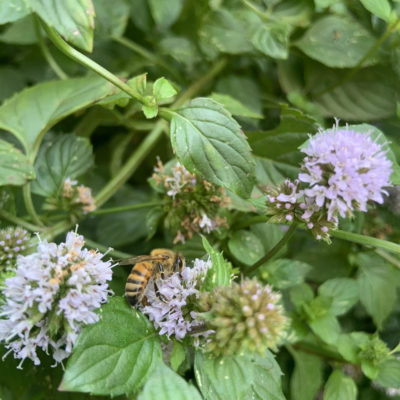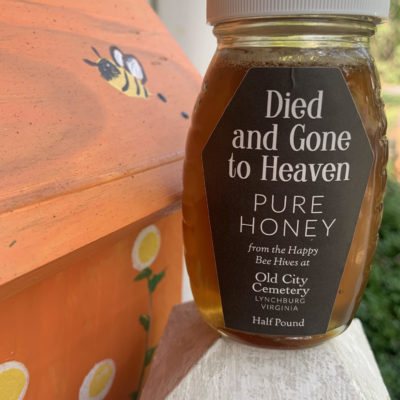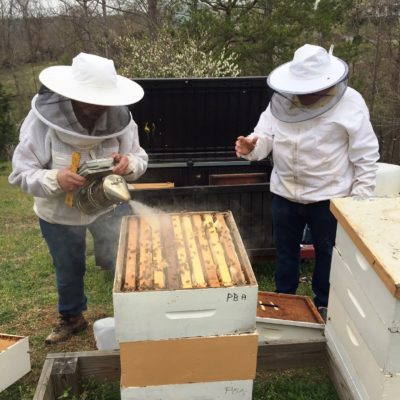September is National Honey Month and here at OCC, our bee hives are buzzing with end-of-summer energy as the tiny but mighty honey bees prepare for the coming cold. So in homage to our GraveGarden pollinators, we took a deeper look into bees, honey, and of course, history.

Honey bee gathers nectar from mint blossom at Old City Cemetery
A Little History…
Honey has been used by humans in food, medicine, spirituality and more for at least 10,000 years. We know this because archaeologists discovered a painting in the Arana Caves in Spain depicting ancient cliffside honey harvesting from wild bees. Honey has also been found preserved for the afterlife in the tombs of the Pharaohs of ancient Egypt – and it was still edible! The ancient Egyptians (and many other ancient cultures) also used honey for embalming, and as a sacrificial offering to their gods.
In medicine, both ancient and current, honey has been used to stem infection, treat cough, insomnia, burns and digestive difficulties, improve eyesight, and aid in the treatment of a laundry list of other ailments. Honey has anti-viral, anti-oxidant, anti-microbial, and anti-inflammatory properties. Due to a few key factors about it’s make-up, microbes and bacteria don’t survive well in honey, and so it has a nearly never-ending shelf life.
The point is, honey has a home in just about every culture in the world, throughout all of human history.
But what is honey? In simple terms, honey is what bees produce using the nectar they eat from flowers. But it really is a complex and intricate process, in which everyone in the hive has a critical role. First, Worker Bees visit flowers in search of nectar. They gobble up the nectar and store it in their “honey stomach” and when the honey stomach is full, they return to the hive, regurgitate the nectar and pass it on to younger House Bees. The house bees deposit the nectar into the hexagon-shaped beeswax cells we know as a honeycombs. They then dry the nectar by producing warm, moving air from their wings. After the nectar has been made thick and sticky, it has become honey. The bees seal off each hexagon cell with a lid of beeswax, and over the winter as the bees become hungry and fresh nectar is hard to come by, they pop open their tiny honey pots and share it among themselves. Luckily for us, they produce far more than they need, and we get to enjoy this sweet honey, too. However, an important task for beekeepers is to ensure that there is always plenty of honey left for the hive!
Of course, honey can vary in flavor and color depending on what plants the bees gather the nectar from. Here at Old City Cemetery, our grounds are home to over 425 different varieties of roses, rows of stunning wildflowers, and an arboretum of beautiful native trees. Thanks to generous contributions and assistance from Blue Ridge Conservation and Hillside Garden Club, we have a Certified Pollinator Garden surrounding our Lotus Pond, and we are in the process of installing a much larger one along the hillside behind the Lotus Pond so that our bees can stay fed and healthy with something in bloom every season of the year. Plus, the honey they produce here has a unique flavor all it’s own and can be purchased in our gift shop!

Died & Gone to Heaven Honey – Made from the Hardworking Hive at Old City Cemetery in Lynchburg, VA.
In the coming months, now that most of the male bees, known as “drones” are kicked out of the hive, the queen will lay her last eggs for the season, and what’s left of the colony will huddle together to keep warm. When the “winter bees” hatch, they’ll be built specifically to withstand the cold. They’ll feed on the honey and pollen reserves that were stored up by the generation before them, and then come spring they’ll begin their work of making honey once more.
How Can You Help?
Bees are essential to life itself, and it is important to do our part. To learn how to create your own Certified Pollinator Garden, go HERE. It’s easier than you may think, and you can probably do it in your own yard! Meanwhile, Old City Cemetery Museums and Arboretum continues to stand as a beautiful balance of life and death, and we invite you to come out and experience it for yourself!

